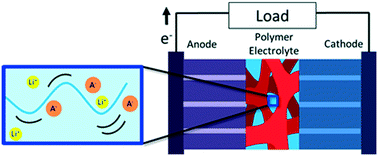Charging toward improved lithium-ion polymer electrolytes: exploiting synergistic experimental and computational approaches to facilitate materials design
Abstract
Ion-conducting polymer electrolytes are attractive materials for all-solid-state lithium-ion batteries (LiBs) as a result of their potential to improve performance, mitigate safety concerns, and facilitate efficient device processing. Understanding how lithium-ionic transport is influenced by the macromolecular features, such as dielectric strength, solvation site connectivity, monomer segment relaxation timescales, segregation strength, and mesophase composition, is crucial for advancing ion-conducting materials. The integration of experimental and computational efforts can provide comprehensive links between chemical and structural characteristics (e.g., ion solvation, chain mobility, morphology) and macroscopic performance properties, accelerating the adoption of next-generation polymer electrolytes. This perspective highlights several synergistic experimental–computational approaches that have provided unique insights into local ion and polymer interactions, chain dynamics, and thermodynamics to promote the rational design of new ion-conducting polymers. Additionally, this work concludes with several suggested areas in which methodologies can be augmented, novel properties can be realized, and polymer electrolytes can be integrated to generate more robust LiB systems.

- This article is part of the themed collection: Charge Transporting Nanostructured Polymers for Electrochemical Systems


 Please wait while we load your content...
Please wait while we load your content...
